Family : Libellulidae

Text © Dr Didier Drugmand
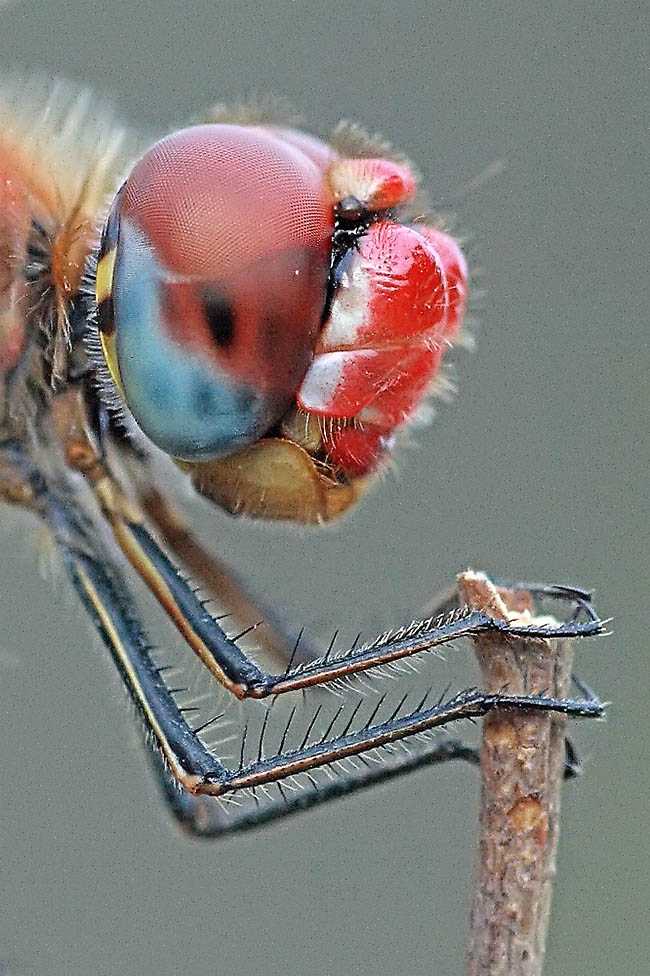
Male of Sympetrum fonscolombii. The bicoloured legs, red and blue eyes and reddish face are typical of the species © Juan Carlos Poveda
Sympetrum fonscolombii (Sélys, 1840) is known in English by the common name of Red-veined Darter (or Sympetrum).
It belongs to the family Libellulidae, in the suborder Anisoptera (dragonflies) of the order Odonata.
The Libellulidae are very similar to the other families of Anisoptera. Unlike the damselflies (suborder Zygoptera like Calopteryx virgo), they have large, spherical eyes that usually meet above the head, and a long, broad, often flattened abdomen.
Their hind wings are not shaped like the front pair and are spread horizontally when the insect lands (in line with the body in damselflies).
The group of cells formed by the veins of the hind wings, which are boot-shaped, is the criterion that distinguishes the Libellulidae from the other families of the suborder.
The body is also free of metallic shine, at least in the European species.
Mature males often develop a fine pale blue bloom on the thorax and abdomen.
The cerci of the females can sometimes be quite large.
These dragonflies like to perch on small, conspicuous supports with their bodies horizontal and their wings folded ready to fly.
In 1840, Baron Edmond de Sélys Longchamps (1813-1900) described the Red-veined Darter as Libellula fonscolombii.
This famous Belgian entomologist, mammalogist and ornithologist dedicated his new species to his colleague, the French entomologist Étienne Laurent Joseph Hippolyte Boyer de Fonscolombe (1772-1853), author of publications on dragonflies, articles on agricultural pests and a treatise on elementary entomology.
E. de Sélys Longchamps’ description is based on several specimens from his observations in Provence in August and in Belgium in July. He then included his new species in the genus Sympetrum created in 1833 by the English entomologist Newman.
The etymology of the name of this genus refers to the shape of the abdomen of these dragonflies. The name Sympetrum is composed of two parts from the Greek “σύμπυκνος” or “sympiknos”, meaning “compressed”, and “ἦτρον” or “êtron”, meaning the abdomen. Sympetrum could therefore be translated as “having a laterally compressed abdomen”.
In French the Red-veined Darter is known as “Sympétrum à nervures rouges”, in Italian as “Cardinale venerosse”, in Spanish as “Dardo de Venas Rojas” (in Catalan as “Pixaví nervat”), in Dutch as “Zwervende heidelibel” and in German as “Frühe Heidelibelle”.
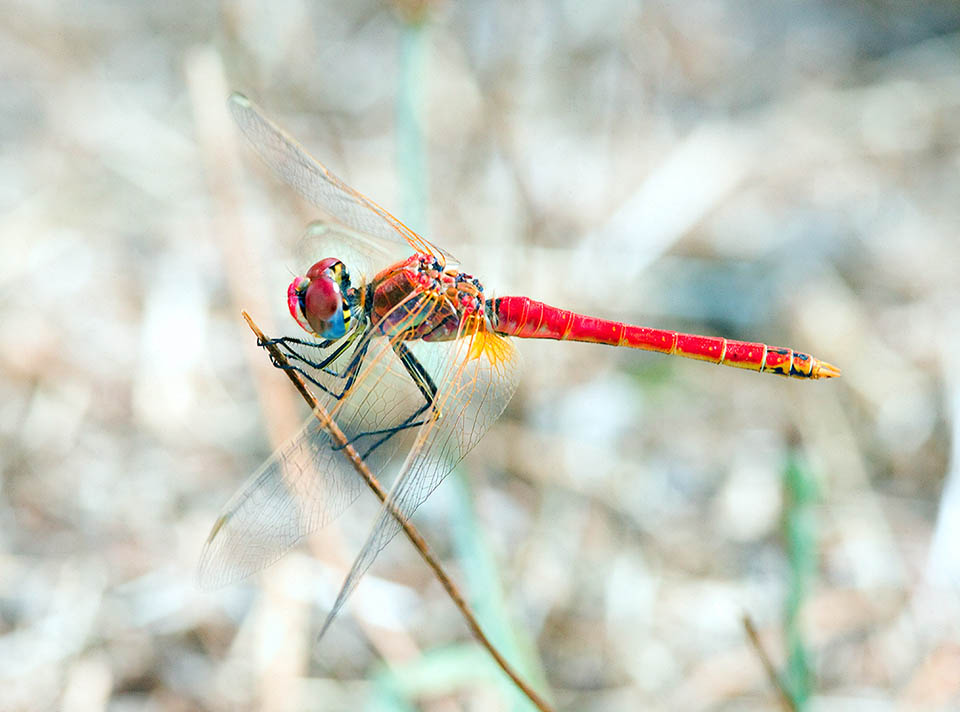
Red-veined darter male on a stem. This species is easily recognised by the pale oblique spot on the thorax and the yellowish colour of the wings © Giuseppe Mazza
The genus Sympetrum comprises 73 species worldwide (except in Oceania, Indonesia, Malaysia, forest areas of South America and Africa) and 11 species in Europe. The seven most widespread species in Europe are the following: Sympetrum flaveolum (Linnæus, 1758); Sympetrum meridionale (Sélys, 1841); Sympetrum pedemontanum (Müller, 1766); Sympetrum sanguineum (Müller, 1764); Sympetrum striolatum (Charpentier, 1840); Sympetrum vulgatum (Linnæus, 1758).
Zoogeography
Sympetrum fonscolombii is a widespread and common species throughout much of Western, Central and Southern Europe, including most Mediterranean islands. It is the only Libellulidae to occur in the Azores, Canary Islands and Madeira. It is also found in North Africa, the Middle East, Mongolia and South West Asia (including the Indian sub-continent, the islands of the Indian Ocean and Sri Lanka). Since the 1990s, the species has been increasingly found in North-Western Europe. This is particularly the case in Belgium, Southern Sweden and Finland, Poland, the UK and Ireland.
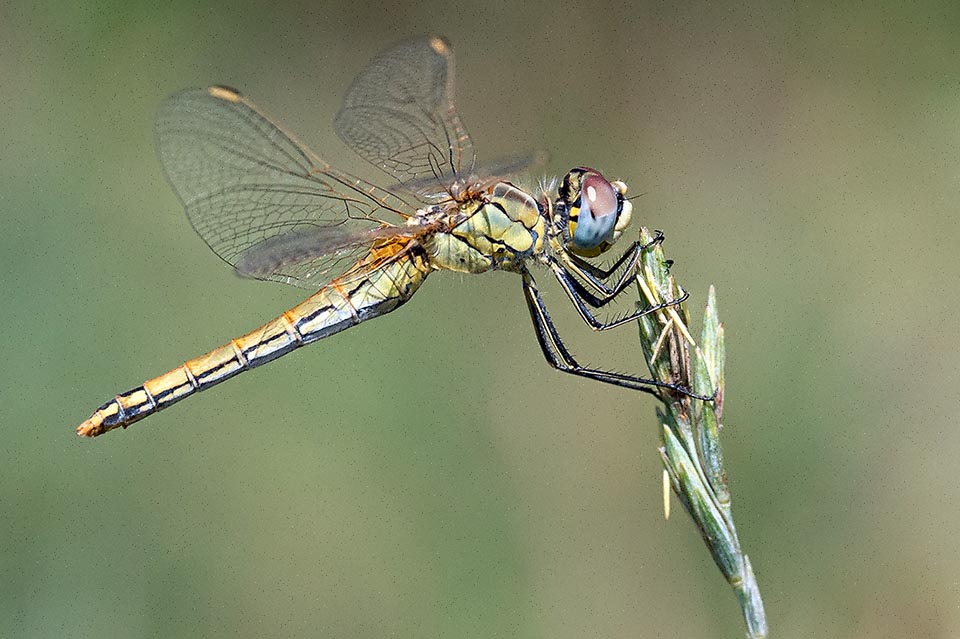
Female with the typical cream face. Some males also have an overall yellowish colour similar to that of the female © Patricia Hoedts
However, it remains to be confirmed whether the expansion of its range is the result of actual establishment of the species in these countries, or annual long-distance migrations, or a combination of both. Some researchers predict that the species will continue to expand its range northwards with the increase in average temperatures caused by current global warming.
The species may migrate in summer in some areas, particularly between France and Italy. These irregular migrations often involve several million individuals. They seem to be triggered by mass emergences in Piedmont, Italy, which take place from the end of July. The movements of the dragonflies were almost always observed close to the ground, between 20 cm and 2 m, either at the level of the passes or on the slopes. Relief and slope winds strongly influence the migrations. The dragonflies maintain their average course towards the West thanks to a solar compass (linked to a recently discovered gene that regulates the internal clock).
This Sympetrum also frequently crosses the Mediterranean to Southern France, Spain and several Mediterranean islands. Other migrations have been reported from Southwest Asia to the Southern Urals and northwards to Western Siberia and the Tien Shan (mountainous areas of Kazakhstan, Kyrgyzstan and Uzbekistan).
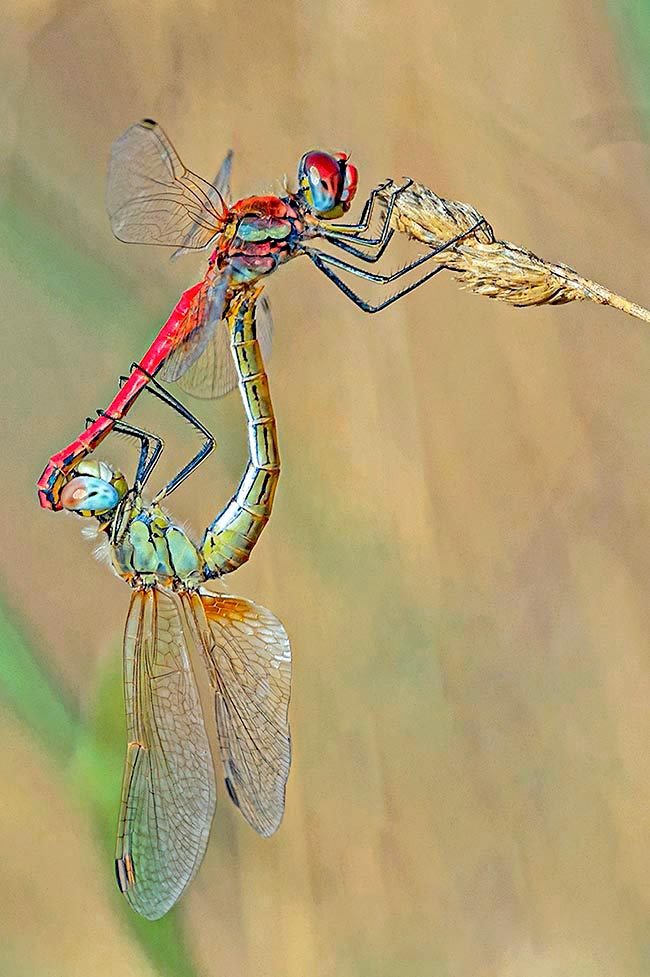
Male and female mate by forming a copulatory heart. Male grasps female at the back of head. The receptive female places the genital pore under the male’s second abdominal segment to receive the sperm in the sperm reservoir © Patricia Hoedts
Ecology-Habitat
This is a pioneer species that prefers freshly dug ponds.
Sympetrum fonscolombii prefers to breed in stagnant water of varying size, but usually shallow and warm, which can dry out in summer.
These are recently created water areas, quarry ponds and eutrophic ponds, but also temporary marshes, flooded sand pits, coastal lagoons, rice fields, etc.
Riverine vegetation is generally poorly developed and floating plants are rare or absent.
Individuals have been observed in all types of water, both stagnant (rich or poor in nutrients) and slightly flowing.
Red-veined Darter larvae develop at the bottom of water, among submerged aquatic vegetation in shallow, sunny stagnant waters.
Adults are highly mobile and often unpredictable. They are regularly found away from water sources during the summer months. They often perch on shore vegetation.
They are ready to pounce on flying prey or intruders entering their territory.
Morphophysiology
The Red-veined Darter is a rather massive anisopteran. With a total length of 33 to 40 mm (22 to 29 mm for the abdomen alone) and a wingspan of +- 66 mm, it is one of the largest species in the genus Sympetrum.
The male is predominantly red. It has a characteristic oblique and distinct patch on the sides of its thorax.
The forewing veins are red and the base of the hindwing has a faint yellow spot.
The dorsal and lateral parts of abdominal segments 7 and 8 are largely black spotted. This is a feature that distinguishes it from the southern Sympetrum. The pterostigmas are pale and bordered by prominent black veins.
The legs of this Sympetrum are black with yellow stripes. Immature males are predominantly yellow: the abdomen, wing veins and forehead do not turn red until the dragonfly reaches maturity.
The female is generally yellowish. She also has two blue-grey eyes, a pale cream face and black spots on the top and sides of the last abdominal segments.
The exuviae and the last larval stage are small (15-20 mm) and stocky. The head is triangular. It has a spoon-shaped mask with no groove at the base and fairly regular teeth. Their abdomen has dorsal spines on segments 6 to 8 and small lateral spines on segments 8 and 9.
This species is closely related to a number of others.
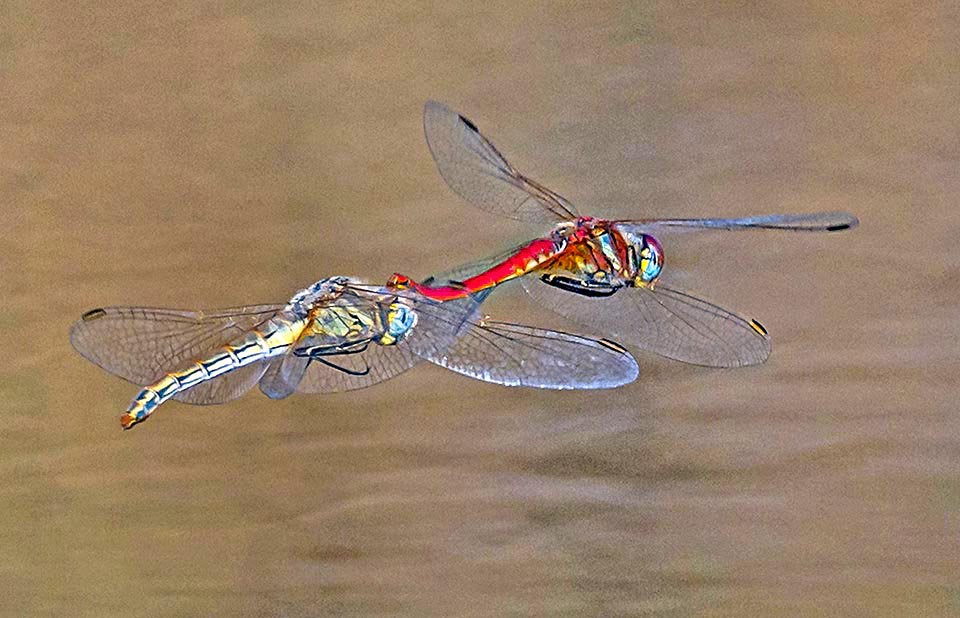
Males and females sometimes fly in tandem, with the male holding the tip of the abdomen against the back of the female’s head © Patricia Hoedts
It differs from them in the following characters : the Yellow-winged Darter (Sympetrum flaveolum) has a broad yellow band at the base of the wing and the lower part of the eyes is yellowish. The Banded Darter (Sympetrum pedemontanum) is characterised by a brown bar running across the wing and touching the pterostigma.
The Black Sympetrum (Sympetrum danae), the Spotted Darter (Sympetrum depressiusculum) and the Ruddy Darter (Sympetrum sanguineum) have completely black legs. Vagrant Darter (Sympetrum vulgatum) and Southern Darter (Sympetrum meridionale) have yellow legs with only a little black on the inside, and the black of the thoracic sutures is almost absent.
In Sympetrum vulgatum, the sides of the thorax are relatively evenly brown. The lower part of the eyes is usually not bluish. The male of the Common Darter (Sympetrum striolatum) has two yellowish stripes on the sides of the thorax. The lower part of the eyes is more yellowish. Both sexes of the Desert Darter (Sympetrum sinaiticum) have a black line on the sides of segments 2 and 3 of the thorax and less dark legs.
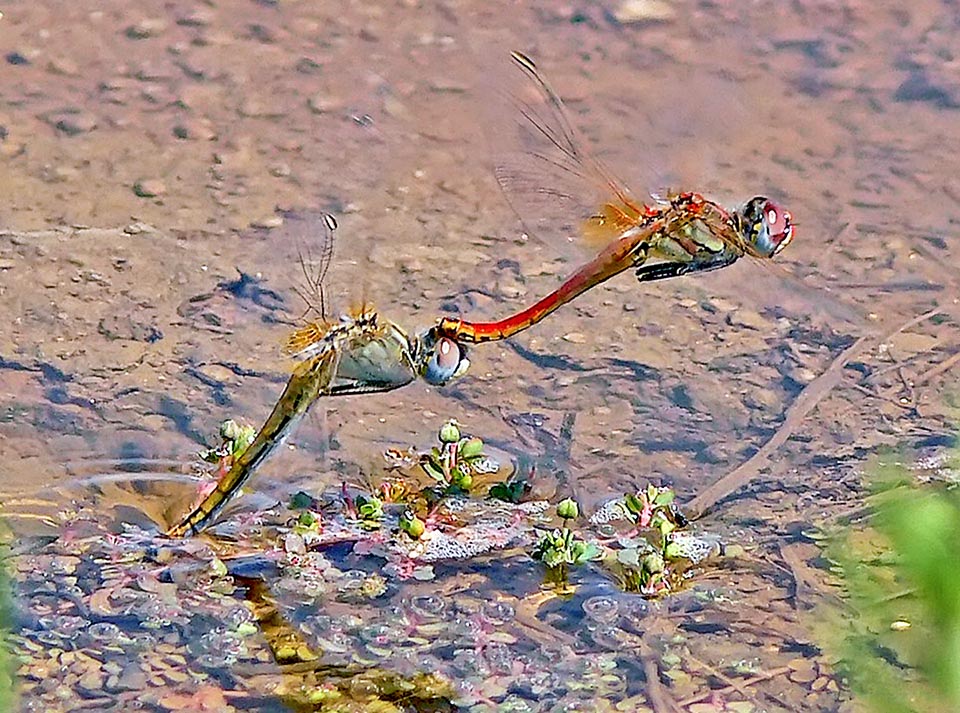
The female lays eggs, alone or with the male, on the surface of the water © Angel Martinez Toro
Ethology and reproductive biology
This Sympetrum, like most species of the genus, is territorial. The male watches his territory from a fixed vantage point (e.g. the top of a water plant) and flies away at the slightest intrusion that violates his “property”. They will chase away any intruders by striking or biting them. It usually returns to the same perch after chasing prey or a rival. Their flight is fast and precise. It often exceeds 50 km/h.
Both males and females of Sympetrum fonscolombii feed by catching flying or moving insects. They often trap dipterans (especially mosquitoes), sexual flying ants, butterflies and sometimes other odonates. Aquatic larvae and nymphs prefer to hunt by lying in wait, hidden in aquatic plants or on the bottom of the water in the sediment.
They attack small invertebrates that come within their reach (insects (adults, eggs (e.g. Culicidae) or larvae (mainly Chironomidae)), cladocerans such as daphnids, annelids…). They also feed on small fish, fry, newts and amphibian tadpoles.
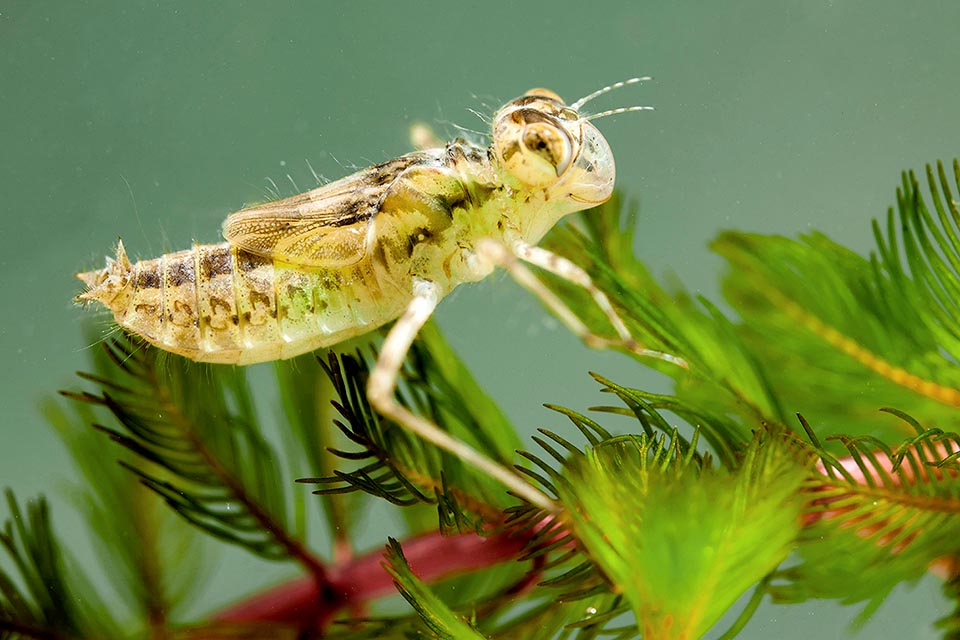
Larva preying on a water plant. It feeds on small invertebrates and even small fish © Christophe Brochard
The female lays her eggs with the male or alone, on the surface of the water and sometimes on wet banks. They hatch in 10 to 25 days. The larval stage, which consists of about ten stages, lasts between 7 and 10 weeks (depending on the country). Very few larvae survive the winter in central and northern Europe.
However, it should be noted that some larvae overwinter in regions with mild winters. Emergence occurs in early spring or summer and adults disperse rapidly once their wings are functional.
In Europe, the flight period of the imago of Sympetrum fonscolombii extends from May to October. Emergence has sometimes been observed in mid-winter in Southern Spain and Morocco. Unlike most other European dragonflies, this species has more than one generation per year (two in Western Europe and three in Spain, sometimes more elsewhere).
The larvae prey on other aquatic invertebrates (beetles such as the dytic, or even larvae of other dragonflies), fish, amphibians (newts, salamander larvae), birds (insectivorous passerines, certain falcons such as the Eleonora’s falcon) or small mammals (water shrews).
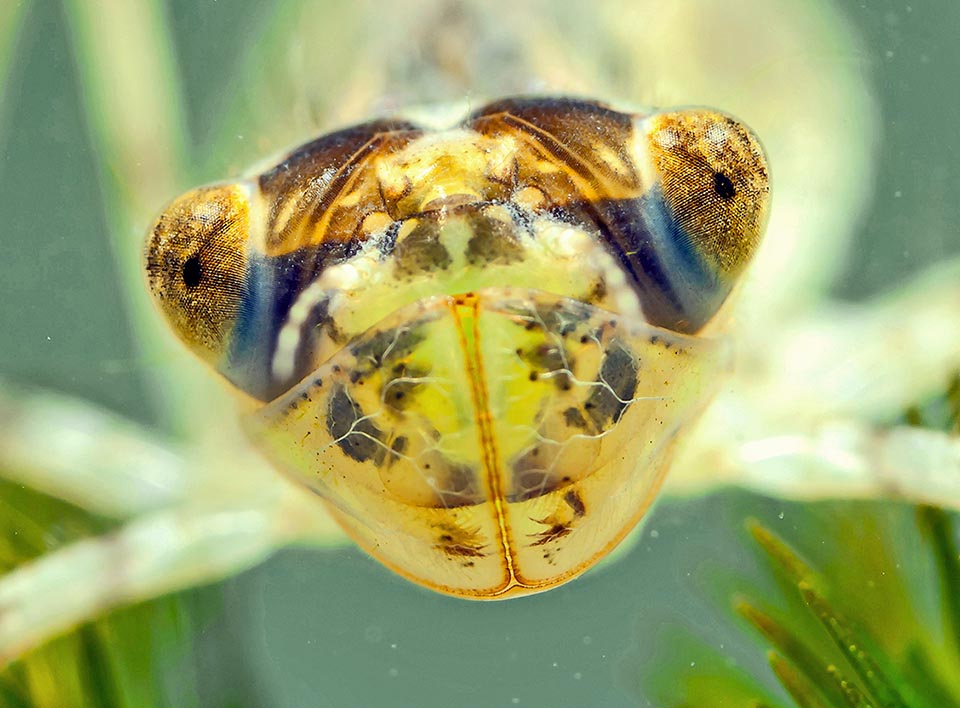
The larva has excellent vision for hunting prey in the water thanks to its two hemispherical eyes on the sides of the triangular head © Christophe Brochard
Some species of spiders (such as the hornet spider Argiope bruennichi (Scopoli, 1772)) are also predators of imagos.
Sympetrum fonscolombii is not threatened with extinction (at least in Southern Europe). This is because it often takes advantage of its migratory habits to breed everywhere. It does not appear on the Red Lists of the European Community or the countries of the Old Continent.
The International Union for Conservation of Nature (IUCN) lists it as ‘Least Concern‘. However, the species is locally threatened by pesticides sprayed near water bodies. Its populations also suffer from the decline, destruction and fragmentation of certain aquatic ecosystems and the eutrophication of wetlands.
Synonyms et other combinations
Libellula fonscolombii Sélys, 1840 (basionyme) ; Tarnetrum fonscolombii (Sélys, 1840) ; Libellula erythroneura Schneider, 1845 ; Sympetrum insignis Brittinger, 1850; Sympetrum azorensis Gardner, 1959; Sympetrum rhaeticum Buchecker, 1876.
